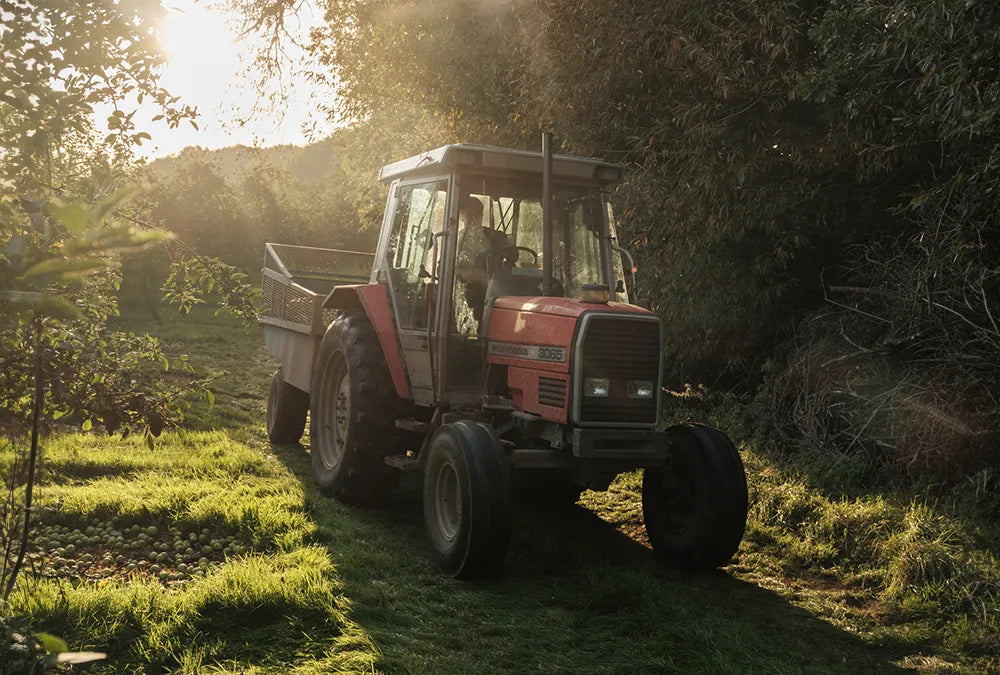
Autumn is cider season. The hum of bees slowly fades, the trees begin to blush, and – after spending the summer swelling and ripening – the first apples in our Somerset orchard begin to fall. Soon after, our Shepton Mallet mill becomes infused with the intoxicating scent of fresh juice as the apples are milled, pressed, and preserved – an olfactory sign that autumn has well and truly arrived.
We grow six different varieties of apples to make our Triple Vintage, which we’ve been growing in the same award-winning orchard for over 180 years. We’ve spent generations getting to know each variety and learning when they are at their prime – after all, like wine, the quality and flavour of our cider comes from the quality, flavour, and blend of our apples.

So, September is when we shake our early bloomers from the trees: the Majors and the White Jerseys and the Brownsapples. We test if each variety is ready by cutting an apple in half and dousing it in an iodine solution that reveals the ratio of sugar to starch (ideally, you want a lot of sugar and not too much starch, along with plenty of juice).
But it’s in November when the stars of our Triple Vintage – Dabbinet apples – are finally ready for harvest. Dabinetts are much higher in tannins and have the perfect balance of sugar and acid, making them perfect for crafting vintage ciders. Once milled, pressed, fermented, and aged, the notes of vanilla and bitter orange are drawn out – flavours that are integral to our Triple Vintage.
This year’s conditions
The ideal conditions for growing the very best apples are cool temperatures with very little rain. This creates a fridge-like environment that keeps the apples in crisp, perfect condition and prevents them from going mushy on the trees. In truth, this autumn hasn’t been the best for cidermaking; it’s been a bit hot and a bit wet, which makes creating the perfect cider a little more challenging (but not impossible).

A wet summer – like the one we’ve just had – means that our apples this year are little larger and a lot juicier, so we’re expecting a high yield of apple juice. In comparison, last summer was far hotter, so the apples we harvested in 2022 were smaller but yielded a much sweeter juice. This is far from a problem – in fact, we love that each vintage we produce is a reflection of the conditions and soil in which the apples were grown. And, as ours is a triple vintage cider, we can mix vintages from across the years – meaning that every batch tastes absolutely perfect.
What happens to our apples next?
The apples that we’re picking right now will be transported seven miles down the road to our mill where they’ll be cleaned. This year, we’ve had quite a lot of rain, so our apples are a bit muddier, which makes the cleaning process a bit more intensive. We’ll then press them to release the juice and their heavenly, appley aroma into the air, before fermenting them for three to four weeks.

We then age our vintages minimum of four months – although we’ve got some barrels dating back to 2017 – and test each barrel every week to check how it’s doing. We always say, ‘when it’s ready, it’s ready,’ because we can immediately tell from the taste if the cider is ‘too green’ (cidermaker speak for ‘it’s not quite mature enough’).
So, our current batch of apples might be ready to join their older compatriots in the spring, or they might make it into a bottle in 2030: finding the right flavour combination for the perfect blend is a delicate balancing act. And as for the trees, they’ll be pruned and cared for over the winter so they’re ready to start all over again in spring.
